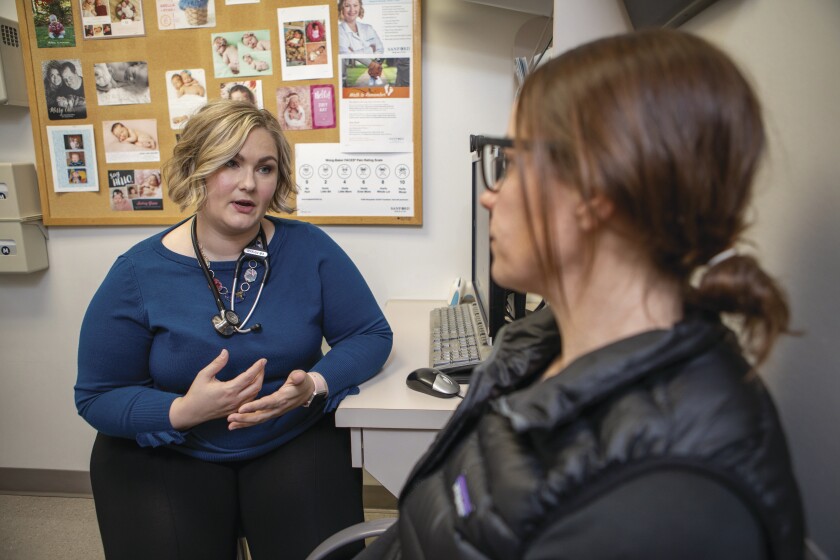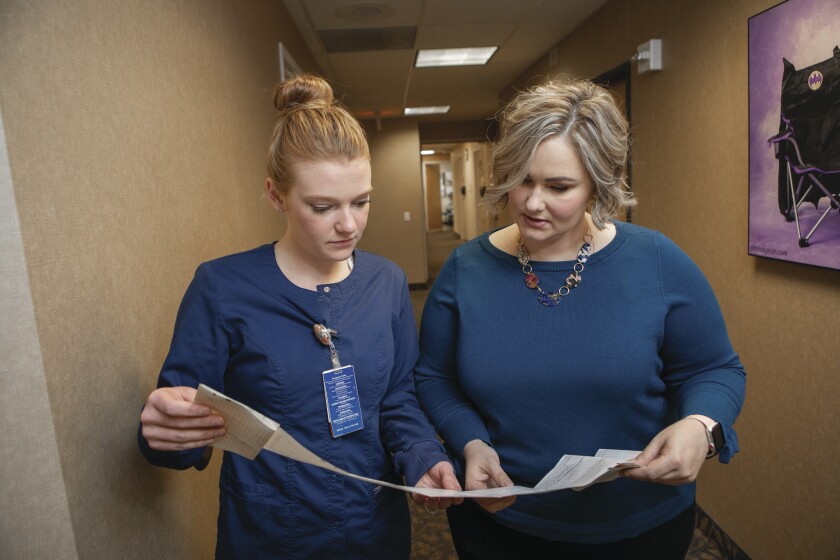BEMIDJI, Minn. -- If there’s a silver lining to the COVID-19 pandemic, it may be how it sped up a change in prenatal care that could improve outcomes for rural mothers and babies.
Dr. Johnna Nynas, an OB/GYN physician at Sanford Health in Bemidji, discussed her hospital’s move to offering virtual visits during the past year.
ADVERTISEMENT
“We started laying the groundwork a couple of years ago,” said Nynas. “We looked at implementing a virtual visit option that provided patients with some equipment to monitor their pregnancies at home, including a blood pressure cuff, and then a Doppler, so they can listen to their baby at home. But what really thrust us to the forefront and accelerated the timeline was the COVID pandemic.”
Technical and legal challenges involved the interface between patients at home and their medical records. But with the onset of the pandemic, Nynas said, “there were rapid changes in Congress that made it much easier for health care organizations to initiate telehealth.”
This created opportunities for physicians to connect with patients remotely, where clinically appropriate. “That really thrust it forward, and we just hit the ground running,” she said. “I think our first visits were in March of 2020. We’ve been doing this for a year now.”
Sanford’s model of virtual prenatal care allows some flexibility with patient scheduling, but there are still core visits where patients are seen in person, Nynas said. Even during the peak of the pandemic, when most people were advised to stay at home, they always offered in-person care for patients who faced a technology barrier or whose pregnancies were too complicated to monitor remotely.
Still, during the last 15 months, Nynas said, “Probably about a third of my patients have done some form of remote care.”

ADVERTISEMENT
Going over well
Nynas said patients’ adoption of telehealth technology has been excellent. “As with any new program, it’s not without its challenges,” she admitted. “But for something that we kind of dove right into, it’s actually going extremely well.”
Advantages, she said, include shifting some responsibility for collecting data onto the patient.
“I think that gives the patients a certain amount of ownership within the process,” she said. “ For instance, it’s really easy, sometimes, to come to the hospital or to the clinic and step on a scale and ignore the number, but if they have to step on the scale and look at the number and repeat it to someone else, that means something different. Same with checking their blood pressure, listening to their babies. I think patients are very engaged.”
From a provider’s perspective, Nynas appreciates the insight virtual visits give her into patients’ home lives.
“The patient’s clinical picture doesn’t stop with the symptoms they’re telling you at the bedside,” she said. “We know that social determinants of health are a huge concern, particularly for women living in rural areas.”
For example, when an expectant mom tells her she is struggling to get good sleep, Nynas can say, “It looks like you’ve got a busy house, with your four kids working on homework and doing distance learning.”
ADVERTISEMENT
“I understand that so much better, being able to see that in real time, than just hearing about it in passing,” she said.
Improving rural access
The feedback from patients has been positive.
“My patients really like the flexibility,” said Nynas. “It’s not exactly the same as having your provider there, but some of the comments are: It feels a lot more personable than they expected it to be. It doesn’t feel as cold or distant as they would expect, even though we’re talking through a computer screen.”
She said it helps that everyone has rapidly adapted to new technologies during recent years, particularly during the pandemic – using FaceTime to video-chat with family, studying via Google Classroom and attending work meetings on Zoom.
It has particularly benefited rural patients, Nynas said. While many rural obstetric hospitals have closed during the past few years, she said, “we’re seeing patients driving farther to get to prenatal care.” Meanwhile, “there’s very good data that women who have to drive more than 30 miles one way for access to prenatal care do not have as good of outcomes as those who do not have to travel so far.”
Nynas explained that telehealth visits provide a real-time way to evaluate a patient and her baby without putting the stress, cost and time of travel onto them, “so she can have as efficient and complete a prenatal care as with somebody who’s living locally.”
ADVERTISEMENT

Here to stay
There are still barriers that need to be addressed, such as broadband and cellular access in rural areas and for lower-income families. And there are days when the technology doesn’t work as well as others, and doctors have to make do with voice-only telephone visits.
Still, Nynas said, virtual visits will likely continue even after COVID-19 fades from public awareness.
“One of my reasons for going into rural practice is, I grew up in a rural area in Minnesota,” she said. “I saw that that distance from the hospital, that distance from medical providers, really impacted the health of my family and the people I grew up with.”
After she specialized as an OB/GYN, she said, “the disparity immediately became very, very clear. Rural women suffer higher maternal morbidity and mortality, higher rates of infant morbidity and mortality. It has to do with timely recognition of medical conditions, and distance is a huge factor in that.”
The disparity is real. Nynas quoted shocking statistics: 23 percent of American women live in rural areas, but only 6% of OB/GYNs practice in rural areas. “That’s the challenge that we’re up against,” she said.
ADVERTISEMENT
The benefit of prenatal care is also real, even for women whose pregnancies are considered low-risk. “It’s better to connect with prenatal care and get that care when and however you can,” said Nynas, “because getting no prenatal care is definitely correlated with worse outcomes.”
At the same time, the costs of running a labor and delivery unit while performing fewer deliveries are widening the gap between rural patients and the care they need. “That’s where being able to offer services remotely can be a really helpful thing,” she said.
Sanford Health recently announced plans to create a virtual hospital, connecting patients at rural hospitals and clinics with specialist care not available in rural areas. Following a “hub and spoke” model, Nynas said, this “can be a really effective way to ensure that patients receive comprehensive care, and that any emergent or urgent medical concern is recognized in a timely manner and addressed before it becomes a life-or-death situation.”
She said she expects to see more and more high-risk conditions safely treated remotely as the health care industry continues to leverage telehealth technology.
“I don’t think this is going away anytime soon,” said Nynas. “I think it’s going to continue to grow, and we’re going to find more and more ways to utilize this for the good of our patients.”









